#Zanobi strozzi
Explore tagged Tumblr posts
Note
Anon rebelde
Nunca dejará de sorprenderme el nivel de hipocresía de ciertos blogs y cuentas anti. La cuenta de IG que manipula la secuencia de las fotos de GETTY para que se ajuste a su enferma fijación por los shippers solo es un ejemplo. En esta noche de deseos, es la noche mágica en España, solo pediria una cosa, que el karma se encargue de devolverles todo el odio que derrochan, después de todo siempre se cosecha lo que se siembra. Feliz noche de Reyes y que los Magos de Oriente acierten con los regalos.
Dear (always returning) Anon Rebelde,
Siempre es un placer leerte y espero que los Reyes os hayan traído paz, salud, amor y alegría a lo largo de este año que ya comienza.
And now, for the translation:
'I will never not be surprised by the level of hypocrisy of some Anti blogs and accounts. The Instagram account that manipulated the succession of the Getty pictures in order to adjust it to their sick obsession on shippers is just an example. On this night of wishful thinking, that is a magical night here, in Spain, I would just wish for one thing: that karma would send all the hatred those people waste in here right back to their faces, after all you always reap what you sow. Happy Twelfth Night and may the Three Kings of Orient get their gifts right.'
Thank you, my dear. Twelfth Night and the Spanish Reyes are very, very important to me on a personal level you certainly have no idea about. The fact that this year I spent most of it on the phone is of no particular import for the dealings in this fandom, but know I treasure your heartfelt thoughts and I thank you from the bottom of my heart, again (and in a rather short timespan: I don't care 😉😘).
I would have never imagined the level of interest for my half-reluctant sharing of a finding I was almost certain wasn't really one. But then I perhaps had no real idea of this fandom's scorching thirst.
If I were a political science or cultural studies professor (which I am, regretfully, not), I would certainly have my students examine the collective behavior patterns I have seen here in just about six months of sojourn. Very enlightening on human nature, with an intercultural twist. This is not necessarily a compliment, by the way.
But let's not taint this sacred day. My favorite king is Balthazar, Anon Rebelde. He wasn't always portrayed as an African, as this painting by Zanobi Strozzi, made just after the Fall of Constantinople, shows us:
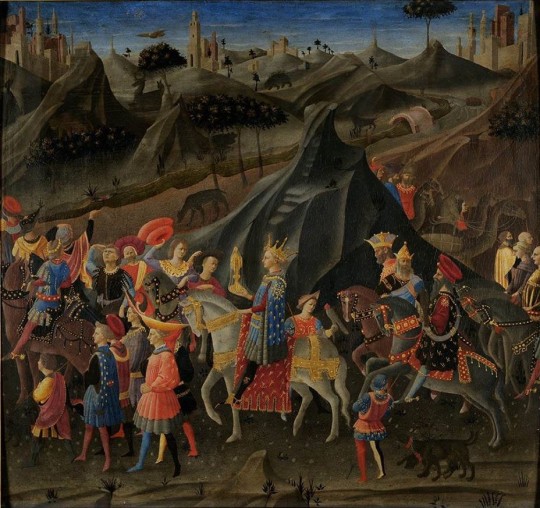
Which one's your favorite?
23 notes
·
View notes
Text
Villa Fabbricotti e il parco
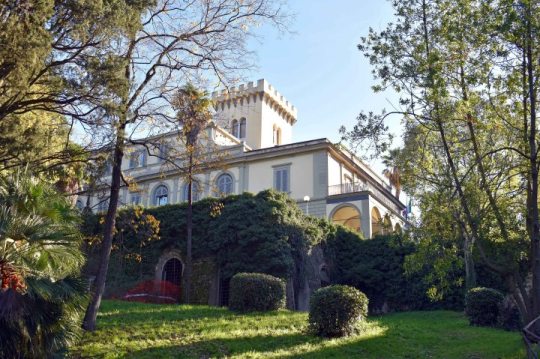
Sulle pendici della collina di Montughi un’elegante villa con parco: siamo su via Vittorio Emanuele II poco prima di via Trieste e dopo via Stibbert, nome dell��omonimo museo con un parco che confina con quello della cosiddetta villa Fabbricotti la cui sistemazione “romantica”, in entrambi, si deve all’architetto Poggi. La storia di villa Fabbricotti la racconta nel suo libro “I dintorni di Firenze” (1875) Guido Carocci che nell’edizione del 1906 scriveva che “fin dal xiv secolo fu della famiglia Boninsegni che aveva le sue case in Firenze sulla piazza vecchia di S. Maria Novella e che le possedette fino all’anno 1525. Il 24 maggio di quell’anno da Alessandra e Gostanza di Lionardo Boninsegni la comprava Girolamo di Zanobi Del Maestro Luca, d’una famiglia che ebbe cappella in S. Trinità presso la quale sorgevano le sue case. Poco dopo, nel 1530, egli la rivendeva ad Alessandro Strozzi e da quell’epoca fino al XIX secolo restò in possesso del ramo di quell’illustre famiglia che si disse dello Strozzino. Nel 1823 fu venduta alla famiglia inglese Wight, poi fu dei Marchesi Zambecari, quindi del celebre tenore Mario Tiberini e finalmente dei Conti Fabbricotti”. Villa Fabbricotti in un’immagine di fine Ottocento Dopo i vari passaggi padronali che il Carocci indica, fu acquistata nel 1864 da Giuseppe Fabbricotti, proprietario di alcune cave di marmo a Carrara. A lui si devono la trasformazione completa dell’originario Casino di caccia degli Strozzi in villa prestigiosa con parco romantico, secondo le tendenze dell’epoca. L’architetto Vincenzo Micheli cui furono affidati i lavori la dotò di una torre merlata che sovrastava l’intera struttura e una terrazza con un loggiato sottostante in stile brunelleschiano che si affacciava sul giardino degradante con terrazze e balconate. Il salone al piano terreno dove aveva soggiornato poco prima di morire (1825)la sorella amatissima di Napoleone, la leggiadra Paolina, fu affrescato da Annibale Gatti che la ritrasse in uno dei medaglioni che ne decoravano il soffitto.
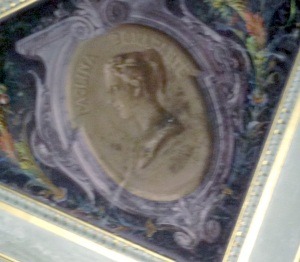
Medaglione con Paolina Bonaparte, particolare.
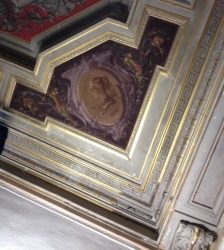
Il soffitto affrescato con il medaglione dedicato a Paolina Bonaparte.

l soffitto del salone del piano terreno che si affaccia sulla terrazza
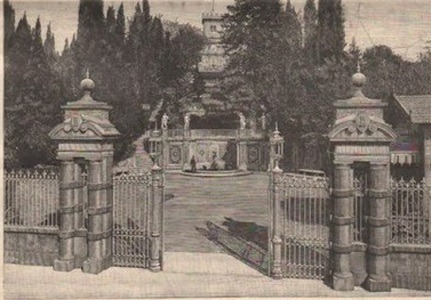
Ingresso con la cancellata e la fontana in un’immagine di fine Ottocento Al grande parco, oggi pubblico, e alla villa si accedeva da via Vittorio Emanuele II su cui si apriva l’imponente ingresso con cancellata: la villa dominava dall’alto il declivio a terrazze e al centro dell’ultima in basso una fontana. Lecci, pini domestici, cipressi, acanti e palme circondavano la villa mentre il giardino si sviluppava in asse con il loggiato su due terrazzamenti collegati da scalinate laterali. E un grande Cedro del Libano dominava con la sua mole lo spiazzo ad ovest accanto alla villa. Il bel Cedro, cui gli esperti avevano dato circa 140 anni, oggi non giganteggia più, a sua memoria rimane un fusto imponente.
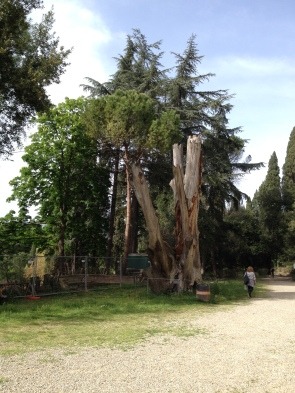
Nel parco accanto alla villa ciò che oggi rimane del grande Cedro del Libano E' nel parco, dall’impianto romantico all’inglese dove natura e architettura armonizzano tra loro, tempietti, fontane, sculture in marmo e terracotta, oggi in parte perdute o rovinate. Sarà certamente piaciuto, nella sua allora originaria struttura, alla regina Vittoria d’Inghilterra che nel 1894 fu ospite della villa
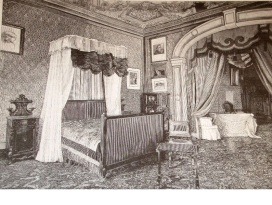
La camera da letto allestita per la regina Vittoria d’Inghilterra ospite della villa nel 1894

La piastra marmorea che commemora il soggiorno della regina Vittoria https://tuttatoscana.net/itinerari-2/a-firenze-villa-fabbricotti-e-il-suo-parco/

Salvina Pizzuoli

tuttatoscana.net Read the full article
0 notes
Photo










The Adimari Book of Hours (Florence, Italy, circa 1448) by Zanobi Strozzi (1412–1468).
Ink, paint and gold on parchment.
Walters Art Museum
Wikimedia.
Creative Commons Attribution-Share Alike 3.0 Unported License
123 notes
·
View notes
Text

Non tutti sanno che a Firenze, nel museo di San Marco, è conservata una tavola che rappresenta una lezione di Alberto Magno. Tra gli uditori riconoscibilissimo è il suo allievo Tommaso d'Aquino (per via dell'aureola). È noto che Tommaso fosse un personaggio riservato, tanto da non proferire parola in pubblico. Una leggenda, però, narra che riuscì ad esporre il suo pensiero davanti a tutti, tanto che lo stesso Alberto esclamò:
"costui che noi chiamiamo bue muto, muggirà così forte da farsi sentire dal mondo intero"
#filosofia#storia della filosofia#filosofi#pillole di filosofia#Filosofia medievale#Medioevo#Citazioni#Frasi#Frasi celebri#Alberto#Alberto magno#Tommaso d'Aquino#Chiesa#Storia del cristianesimo#Cristianesimo#Firenze#Tavola#Zanobi strozzi
4 notes
·
View notes
Photo

05 Works, Today, April 20th, is St. Agnes of Montepulciano’s day, With Footnotes – #106 Agnes of Montepulciano, O.P. (1268–1317), was a Dominican prioress in medieval Tuscany, who was known as a miracle worker during her lifetime.
#Agnes of Montepulciano#Ambrogio Borgognone#Art#Bible#Biography#Christ#Classical#Figurative#Fine Art#footnotes#History#Icons#Jesus#mythology#religion#Zaidan#Zanobi Strozzi
1 note
·
View note
Text
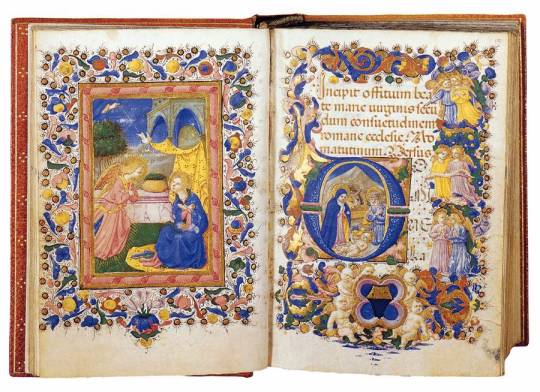


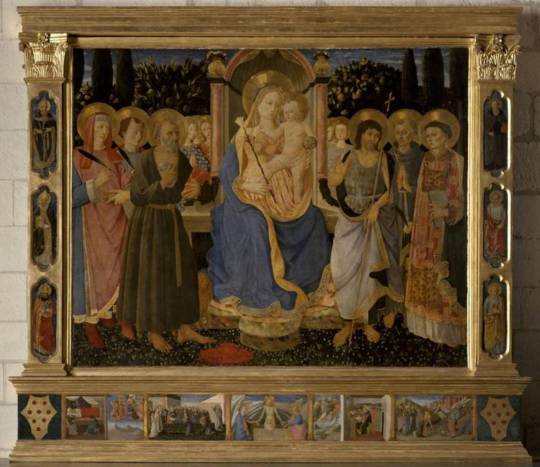

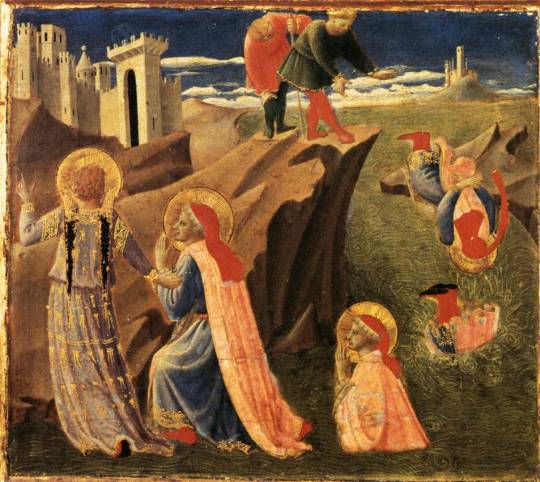

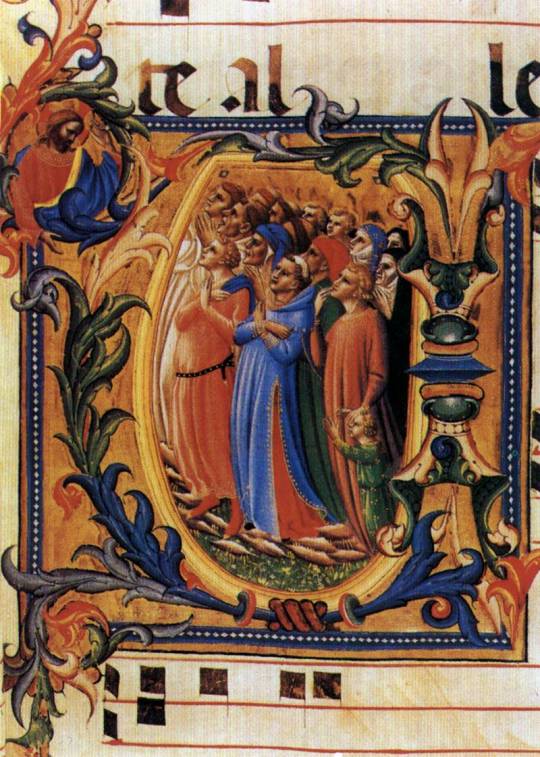
By: Amy Fredrickson
The illuminator and painter Zanobi di Benedetto di Caroccio degli Strozzi was born into one of the largest and wealthiest families in Florence on 17 November 1412, although during his lifetime the Strozzi family would lose their battle for supremacy of Florence to the Medici. While Zanobi was primarily active as an illuminator, he also produced both private devotional works and altarpieces.
Zanobi, along with his older brother Francesco and sister Maddalena, were orphaned when he was fifteen. There is a lack of documentation regarding his early life, but tax records prove that between 1427 and 1430 he was living with the illuminator Battista di Biagio Sanguigni (1393-1451) in nearby Fiesole. Due to his aristocratic status, he began his training privately with Sanguigni, rather than an apprenticeship in a workshop. Sanguigni and Zanobi collaborated on several projects. The artists remained close, and in 1432 Sanguigni helped pay Maddalena’s dowry when she entered the Augustinian convent of San Gaggio. In total, the duo lived together for between eight and eleven years. Zanobi provided his tutor with financial support for another fourteen years. He also provided provisions and wine, and he even deeded the Strozzi property in Palaiuola to Sanguigni in 1446 when Zanobi moved back to Florence with his wife Nanna di Francesco Strozzi. Sanguigni continued to live in Palaiuola until his death in 1451 when the property reverted back to Zanobi’s brother, Francesco Strozzi.
Due to their close working relationship, Sanguigni and Zanobi have rather similar styles. In Fiesole, the duo connected with Fra Angelico, whom they met at San Domenico, where Fra Angelico was working at the time. In Lives, Vasari included Zanobi in the friar’s biography, claiming that Zanobi was a fervent follower.
Interestingly, due to the regulations of the Florentine guilds, an aristocrat could neither rule the city nor take an active part in politics. Consequently, Zanobi never registered with the Arte dei Medici e Speziali in Florence and was therefore unable to secure commissions under his own name; the majority of his works are collaborations.
When Zanobi arrived in Florence, he may have been a tenant in Pesellino’s workshop, as there are no documents that prove he purchased his own studio until several years later. Another possibility is that he entered some type of formal partnership with Pesellino (c.1422 - 1457). They worked on an altarpiece together, and the main panel is The Assumption of the Virgin located in the National Gallery of Art in Dublin. Scholars have proposed different ideas regarding how much each artist participated in this work. They also worked on an illumination of the Bellum Poenicum from 1446 to 1449.
Between 1446 and 1454, Zanobi collaborated with Filippo di Matteo Torelli on Cosimo de’ Medici’s commission for choir books for the church of San Marco. Fra Angelico reviewed the miniatures according to a document dated 2 May 1449. In 1460, shortly after finishing the choir books, the Medici also ordered an altarpiece for the church of San Girolamo in Fiesole, which was in proximity to their new Villa Medici. In 1463, he began another large commission to illuminate choir books for the Cattedrale di Santa Maria del Fiore. For this project, he collaborated with Francesco di Antonio del Chierico. It took eleven years to finish these works, even with the help of an entire workshop. In fact, the workshop incorporated several notable Florentine artists, including Cosimo Rosselli and Domenico Ghirlandaio.
While he worked primarily as an illuminator, he left behind several paintings. Zanobi’s only signed work is an Annunciation (c. 1440-1445) for the church of San Miniato al Monte, now housed in the National Gallery, London. The Lanfredini family commissioned this work for their private chapel in San Miniato al Monte. Zanobi depicted a traditional scene with the Virgin seated in prayer and the angel Gabriel announcing that she will bear the Son of God. Above Gabriel he placed a dove to represent the Holy Spirit, and he incorporated the lily as an emblem of the Virgin’s purity and grace. He also included the Lanfredini family arms on the capitals of the columns in the painting, and he concealed his signature, “ZANOBI,” on the border of the Virgin's blue robe.
The Philadelphia Museum of Art also holds an Annunciation in its collection, which demonstrates Fra Angelico’s influence on Zanobi's iconographic choices. His decision to portray the angel Gabriel flying in on clouds is unconventional, yet while working in Fiesole, he may have seen Fra Angelico’s 1425 missal depicting Gabriel in the same manner. Additionally, in 1434, Fra Angelico depicted Gabriel in pink robes in an Annunciation for the convent of Santa Maria Novella. In this work, Gabriel's garb is a similar distinctive pink ensemble adorned with gold embroidery. The painting supports Vasari’s statement that Zanobi worked with Fra Angelico and had an impact on Zanobi’s paintings.
The artist died in his native Florence on 6 December 1468 and is buried in Santa Maria Novella. Zanobi is most remembered for his miniatures in illuminated manuscripts and is considered by some as one of the minor masters of his generation.
References:
D'Ancona, Mirella Levi. "Zanobi Strozzi Reconsidered," La Bibliofilía 61, no. 1, 1959, pp.1-38.
Kanter, Laurence, "Battista di Biagio Sanguini and Zanobi Strozzi, " Fra Angelico, ed. Laurence Kanter and Pia Palladino, (New York: The Metropolitan Museum of Art, 2005).
Leader, Anne, The Badia of Florence, (Bloomington: Indiana University Press, 2012).
Little, Amanda, Florentine Villas in the Fifteenth Century: An Architectural and Social History, (New York: Cambridge University Press, 2005).
Mayer Thurman, Christa C, Laurence B Kanter, Barbara Drake Boehm, Carl Brandon Strehlke, Gaudenz Freuler, and Pia Palladino, Painting And Illumination In Early Renaissance Florence, 1300-1450, (New York: The Metropolitan Museum of Art, 1995).
Pope-Hennessy, John, The Robert Lehman Collection: Vol. 4, Illuminations, (New York: The Metropolitan Museum of Art, 1997).
Strehlke, Carl Brandon, Italian Paintings 1250-1450 in The John G. Johnson Collection and The Philadelphia Museum Of Art, (University Park: Pennsylvania State Univ. Press, 2004).
Vasari, Giorgio, The Lives Of The Artists, ed. George Anthony Bull, (Harmondsworth: Penguin, 1997).
Images:
Book of Hours for the Use of Rome, c. 1445, Manuscript, 135 x 93 mm, Walters Art Museum, Baltimore.
The Annunciation, 1440-1445, Panel, 104.5 x 142 cm, The National Gallery of London.
Madonna of Humility with Two Musician Angels, 1448-50, Panel, 84 x 57 cm, Museo Poldi Pezzoli, Milan.
St Jerome Altarpiece, 1460s, Oil on wood, 220 x 261 cm, Musée du Petit Palais, Avignon.
The Annunciation, c. 1453, Tempera and gold on panel, 37 x 30 cm, Museum of Art, Philadelphia.
Saints Cosmas and Damian Saved from Drowning, c. 1435, Tempera and gold on panel, 20 x 22 cm, Museo di San Marco, Florence.
Madonna and Child with Angels, c. 1434, Tempera and gold on panel, 138 x 127 cm, Museo di San Marco, Florence.
Gradual, 1450-55, Manuscript (Corale 3), Biblioteca Medicea Laurenziana, Florence
#Zanobi Strozzi#Fra Angelico#Italian Renaissance#Florence#religious art#cosimo de' medici#Fiesole#Italian art#fifteenth-century painting#art#arthistory#Pesellino#miniature#illuminated manuscript
46 notes
·
View notes
Text

The Annunciation 1440
Zanobi Strozzi (1412-1468)
Egg tempera on wood
Fotografato alla National Gallery di Londra
1 note
·
View note
Photo

Annunciation, by Zanobi Strozzi, Philadelphia Museum of Art, Philadelphia.
109 notes
·
View notes
Video
<strong>Gloria in Excelsis Deo <a href="https://www.flickr.com/photos/paullew/">by Fr Lawrence Lew, O.P.</a></strong> <br /><i>Via Flickr:</i> <br />This charming picture, now in the MMA in New York, seems to have been painted in Fra Angelico's workshop in about 1440. It is attributed to Zanobi Strozzi.
#Biblical#Nativity#Christmas#Jesus Christ#Blessed VIrgin Mary#St Joseph#Metropolitan Museum of Art#MMA#New York#angels#manger#Zanobi Strozzi#Strozzi#italian#male artist#1440s#renaissance
4 notes
·
View notes
Text

Zanobi Strozzi - Madonna of Humillity. 1446 - 1448
53 notes
·
View notes
Photo

5 janvier - Vigile de l'Epiphanie du Seigneur Le cortège des rois mages. Zanobi Strozzi c.1445 Musée des beaux-Arts, Strasbourg https://bit.ly/3eQgpEf
14 notes
·
View notes
Photo

The Nativity, Zanobi Strozzi, ca. 1433–34, European Paintings
Gift of May Dougherty King, 1983 Size: 7 3/8 x 17 1/8 in. (18.7 x 43.5 cm) Medium: Tempera and gold on wood
https://www.metmuseum.org/art/collection/search/435578
5 notes
·
View notes
Photo

"Sts Cosmas and Damian Saved from Drowning" Zanobi Strozzi Tempera and gold on panel, c. 1435 Museo di San Marco, Florence
3 notes
·
View notes
Text
No Other Angel
No other angel Had such a mission ~ To virgin Flesh ~ A seed Of good news ~ Sown Of a cosmic miracle ~ That here Within her ~ At this time Now must start. ~ Zanobi Strozzi The Annunciation about 1440-5 Egg tempera on wood, 104.5 x 142 cm Bought, 1894 NG1406 https://www.nationalgallery.org.uk/paintings/NG1406

View On WordPress
0 notes
Photo

Saint of the Day – 18 February – Blessed John of Fiesole/Fra Angelico O.P. (1387-1455) Born in 1387 in Vicchio di Mugello near Florence, Italy as Guido di Pietro – he died on 18 February 1455 in the Dominican convent in Rome, Italy of natural causes. He was known to contemporaries as Fra Giovanni da Fiesole (Brother John of Fiesole) and Fra Giovanni Angelico (Angelic Brother John). In modern Italian he is called il Beato Angelico (Blessed Angelic One); the common English name Fra Angelico means the “Angelic friar”. In 1982, Pope John Paul II proclaimed his beatification in recognition of the holiness of his life, thereby making the title of “Blessed” official. Fiesole is sometimes misinterpreted as being part of his formal name but it was merely the name of the town where he took his vows as a Dominican friar and was used by contemporaries to separate him from others who were also known as Fra Giovanni. He is listed in the Roman Martyrology as Beatus Ioannes Faesulanus, cognomento Angelicus—”Blessed Giovanni of Fiesole, surnamed ‘the Angelic’ “. Patron of Catholic Artists.

Fra Angelico was an Early Italian Renaissance painter described by Vasari in his Lives of the Artists as having “a rare and perfect talent”.
Early life, 1395–1436 Fra Angelico was born Guido di Pietro at Rupecanina in the Tuscan area of Mugello near Fiesole towards the end of the 14th century. Nothing is known of his parents. He was baptised Guido or Guidolino. The earliest recorded document concerning Fra Angelico dates from 17 October 1417 when he joined a religious confraternity or guild at the Carmine Church, still under the name of Guido di Pietro. This record reveals that he was already a painter, a fact that is subsequently confirmed by two records of payment to Guido di Pietro in January and February 1418 for work done in the church of Santo Stefano del Ponte. The first record of Angelico as a friar dates from 1423, when he is first referred to as Fra Giovanni (Friar John), following the custom of those entering one of the older religious orders of taking a new name. He was a member of the local community at Fiesole, not far from Florence, of the Dominican Order; one of the medieval Orders belonging to a category known as mendicant Orders because they generally lived not from the income of estates but from begging or donations. Fra, a contraction of frater (Latin for ‘brother’), is a conventional title for a mendicant friar.
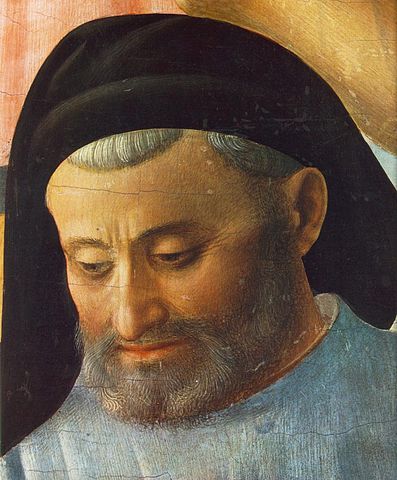
According to Vasari, Fra Angelico initially received training as an illuminator, possibly working with his older brother Benedetto who was also a Dominican and an illuminator. The former Dominican convent of San Marco in Florence, now a state museum, holds several manuscripts that are thought to be entirely or partly by his hand. The painter Lorenzo Monaco may have contributed to his art training and the influence of the Sienese school is discernible in his work. He had several important charges in the convents he lived in but this did not limit his art, which very soon became famous. According to Vasari, the first paintings of this artist were an altarpiece and a painted screen for the Charterhouse (Carthusian monastery) of Florence; none such exist there now.
From 1408 to 1418, Fra Angelico was at the Dominican friary of Cortona, where he painted frescoes, now mostly destroyed, in the Dominican Church and may have been assistant to Gherardo Starnina or a follower of his. Between 1418 and 1436 he was at the convent of Fiesole, where he also executed a number of frescoes for the church and the Altarpiece, which was deteriorated but has since been restored. A predella of the Altarpiece remains intact and is conserved in the National Gallery, London, and is a great example of Fra Angelico’s ability. It shows Christ in Glory surrounded by more than 250 figures, including beatified Dominicans.
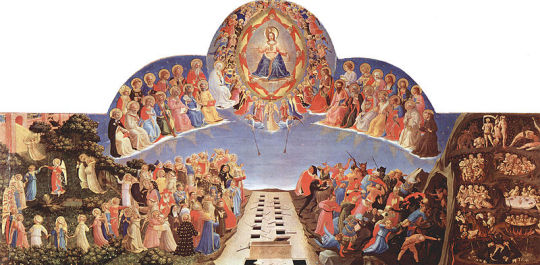
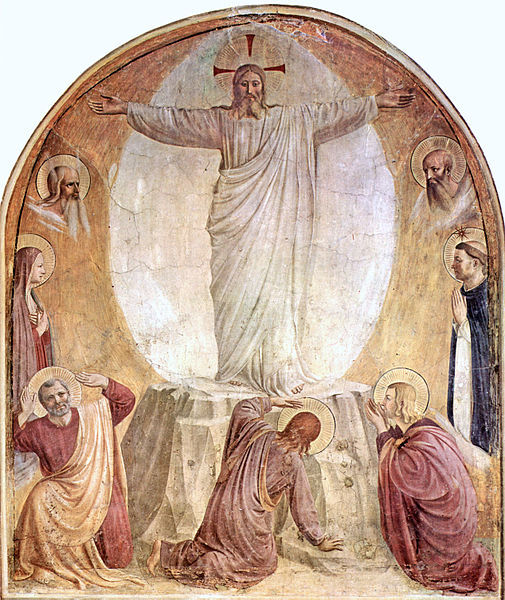
The Last Judgement and The Transfiguration shows the directness, simplicity and restrained palette typical of these frescoes. Located in a monk’s cell at the Convent San’ Marco and intended for private devotion.
San Marco, Florence, 1436–1445 In 1436, Fra Angelico was one of a number of the friars from Fiesole who moved to the newly built convent or friary of San Marco in Florence. This was an important move which put him in the centre of artistic activity of the region and brought about the patronage of one of the wealthiest and most powerful members of the city’s governing authority, or “Signoria” (namely Cosimo de’ Medici), who had a cell reserved for himself at the friary in order that he might retreat from the world.
It was, according to Vasari, at Cosimo’s urging that Fra Angelico set about the task of decorating the convent, including the magnificent fresco of the Chapter House, the often-reproduced Annunciation at the top of the stairs leading to the cells, the Maesta (or Coronation of the Madonna) with Saints (cell 9) and the many other devotional frescoes, of smaller format but remarkable luminous quality, depicting aspects of the Life of Christ that adorn the walls of each cell.
In 1439 Fra Angelico completed one of his most famous works, the San Marco Altarpiece at Florence. The result was unusual for its time. Images of the enthroned Madonna and Child surrounded by saints were common, but they usually depicted a setting that was clearly heaven-like, in which saints and angels hovered about as divine presences rather than people. But in this instance, the saints stand squarely within the space, grouped in a natural way as if they were able to converse about the shared experience of witnessing the Virgin in glory. Paintings such as this, known as Sacred Conversations, were to become the major commissions of Giovanni Bellini, Perugino and Raphael.
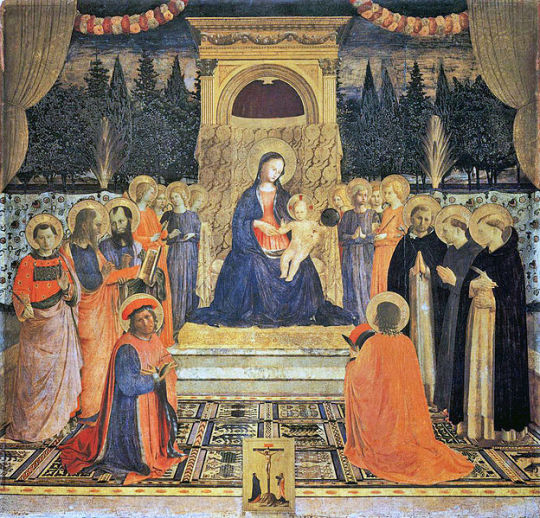
San Marco Altarpiece
The Vatican, 1445–1455 In 1445 Pope Eugene IV summoned him to Rome to paint the frescoes of the Chapel of the Holy Sacrament at St Peter’s, later demolished by Pope Paul III. Vasari claims that at this time Fra Angelico was offered the Archbishopric of Florence by Pope Nicholas V and that he refused it, recommending another friar for the position. The story seems possible and even likely. However, if Vasari’s date is correct, then the pope must have been Eugene IV and not Nicholas, who was elected Pope only on 6 March 1447. Moreover, the archbishop in 1446–1459 was the Dominican Antoninus of Florence (Antonio Pierozzi), canonised by Pope Adrian VI in 1523. In 1447 Fra Angelico was in Orvieto with his pupil, Benozzo Gozzoli, executing works for the Cathedral. Among his other pupils were Zanobi Strozzi.
From 1447 to 1449 Fra Angelico was back at the Vatican, designing the frescoes for the Niccoline Chapel for Nicholas V. The scenes from the lives of the two martyred deacons of the Early Christian Church, St Stephen and St Lawrence may have been executed wholly or in part by assistants. The small chapel, with its brightly frescoed walls and gold leaf decorations gives the impression of a jewel box. From 1449 until 1452, Fra Angelico returned to his old convent of Fiesole, where he was the Prior.
Death and beatification In 1455, Fra Angelico died while staying at a Dominican convent in Rome, perhaps on an order to work on Pope Nicholas’ chapel. He was buried in the church of Santa Maria sopra Minerva.
When singing my praise, don’t liken my talents to those of Apelles. Say, rather, that, in the name of Christ, I gave all I had to the poor.
The deeds that count on Earth are not the ones that count in Heaven.
I, Giovanni, am the flower of Tuscany. — Translation of epitaph
The English writer and critic William Michael Rossetti wrote of the friar:
“From various accounts of Fra Angelico’s life, it is possible to gain some sense of why he was deserving of canonisation. He led the devout and ascetic life of a Dominican friar and never rose above that rank; he followed the dictates of the order in caring for the poor; he was always good-humoured. All of his many paintings were of divine subjects and it seems that he never altered or retouched them, perhaps from a religious conviction that, because his paintings were divinely inspired, they should retain their original form. He was wont to say that he who illustrates the acts of Christ should be with Christ. It is averred that he never handled a brush without fervent prayer and he wept when he painted a Crucifixion. The Last Judgement and the Annunciation were two of the subjects he most frequently treated.”

The Crucified Christ
Pope John Paul II beatified Fra Angelico on 3 October 1982 and in 1984 declared him patron of Catholic artists.
“Angelico was reported to say “He who does Christ’s work must stay with Christ always”. This motto earned him the epithet “Blessed Angelico” because of the perfect integrity of his life and the almost divine beauty of the images he painted, to a superlative extent those of the Blessed Virgin Mary.”— St Pope John Paul II


(via AnaStpaul – Breathing Catholic)
33 notes
·
View notes
